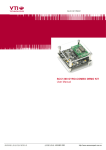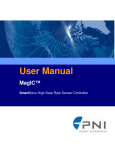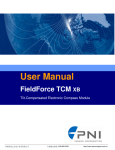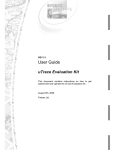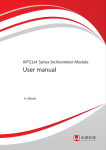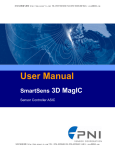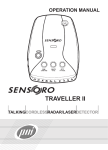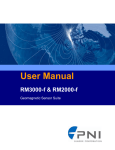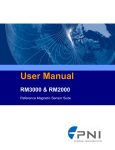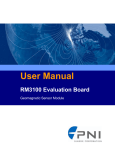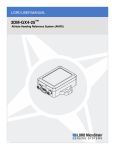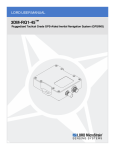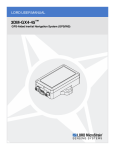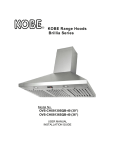Download User Guide
Transcript
User Manual
MicroMagIC™
3 Axis High Data Rate Magnetic Sensor Module
Table of Contents 1 COPYRIGHT & WARRANTY INFORMATION .............................................................. 3 2 OVERVIEW..................................................................................................................... 4 3 SPECIFICATIONS .......................................................................................................... 5 4 TYPICAL OPERATING CHARACTERISTICS .............................................................. 6 5 MECHANICAL DRAWING ............................................................................................. 8 6 SET-UP ......................................................................................................................... 10 6.1 PCB ORIENTATION AND OUTPUT POLARITIES ...................................... 10 6.2 BOARD CONNECTIONS AND TEST POINTS ............................................ 11 6.3 CLOCK OPTIONS......................................................................................... 13 7 OPERATION................................................................................................................. 16 7.1 MAKING A MEASUREMENT........................................................................ 16 7.1.1 Slave Select ..................................................................................... 17
7.1.2 Idle Mode ......................................................................................... 18 7.1.3 SPI Interface Considerations ........................................................... 18 7.2 REGISTER DEFINITION .............................................................................. 19 List of Figures Figure 4-1:
Figure 4-2:
Figure 4-3:
Figure 4-4:
Figure 5-1:
Figure 5-1:
Figure 6-1:
Figure 6-2:
Figure 6-3:
Figure 6-4:
Figure 6-5:
Figure 7-1:
Figure 7-2:
Period Select vs. Data Rate per Axis ....................................................... 6 Output Counts vs. Magnetic Field and Temperature ............................... 6 Linearity vs. Temperature ........................................................................ 7 Repeatability and Hysteresis ................................................................... 7 MicroMagIC Mechanical Drawing – Top View ......................................... 8 MicroMagIC Mechanical Drawing – Side View ........................................ 9 MicroMagIC Orientation ......................................................................... 10 Default Strap Configuration ................................................................... 13 Strapping Configuration for Clock Source.............................................. 14 Strapping Configuration for Clock Output .............................................. 15 Strapping Configuration for Clock Speed ............................................... 15 SPI Interface Sequence ......................................................................... 17 SPI Interface Timing .............................................................................. 17 List of Tables Table 3-1:
Table 3-2:
Table 6-1:
Table 6-2:
Table 7-1:
Table 7-2:
Absolute Maximum Ratings ....................................................................... 5 Module Characteristics1 ............................................................................ 5 Board Connection Pin-Out .......................................................................11 Test Points ............................................................................................... 13 Command Register ................................................................................. 19 Results Register ...................................................................................... 20 深圳市铭之光电子技术有限公司 全国服务热线 : 400-883-3391
http://www.sensorexpert.com.cn
1 Copyright & Warranty Information
© Copyright PNI Sensor Corporation 2009
All Rights Reserved. Reproduction, adaptation, or translation without prior written permission is prohibited, except as allowed under copyright
laws.
Revised April 2009: for the most recent version visit our website at www.pnicorp.com
PNI Sensor Corporation
133 Aviation Blvd, Suite 101
Santa Rosa, CA 95403, USA
Tel: (707) 566-2260
Fax: (707) 566-2261
Warranty and Limitation of Liability. PNI Sensor Corporation ("PNI") manufactures its Products from parts and components that are new or
equivalent to new in performance. PNI warrants that each Product to be delivered hereunder, if properly used, will, for one year following the date
of shipment unless a different warranty time period for such Product is specified: (i) in PNI’s Price List in effect at time of order acceptance; or (ii)
on PNI’s web site (www.pnicorp.com) at time of order acceptance, be free from defects in material and workmanship and will operate in
accordance with PNI’s published specifications and documentation for the Product in effect at time of order. PNI will make no changes to the
specifications or manufacturing processes that affect form, fit, or function of the Product without written notice to the Customer, however, PNI
may at any time, without such notice, make minor changes to specifications or manufacturing processes that do not affect the form, fit, or
function of the Product. This warranty will be void if the Products’ serial number, or other identification marks have been defaced, damaged, or
removed. This warranty does not cover wear and tear due to normal use, or damage to the Product as the result of improper usage, neglect of
care, alteration, accident, or unauthorized repair.
THE ABOVE WARRANTY IS IN LIEU OF ANY OTHER WARRANTY, WHETHER EXPRESS, IMPLIED, OR STATUTORY, INCLUDING, BUT
NOT LIMITED TO, ANY WARRANTY OF MERCHANTABILITY, FITNESS FOR ANY PARTICULAR PURPOSE, OR ANY WARRANTY
OTHERWISE ARISING OUT OF ANY PROPOSAL, SPECIFICATION, OR SAMPLE. PNI NEITHER ASSUMES NOR AUTHORIZES ANY
PERSON TO ASSUME FOR IT ANY OTHER LIABILITY.
If any Product furnished hereunder fails to conform to the above warranty, Customer’s sole and exclusive remedy and PNI’s sole and exclusive
liability will be, at PNI’s option, to repair, replace, or credit Customer’s account with an amount equal to the price paid for any such Product which
fails during the applicable warranty period provided that (i) Customer promptly notifies PNI in writing that such Product is defective and furnishes
an explanation of the deficiency; (ii) such Product is returned to PNI’s service facility at Customer’s risk and expense; and (iii) PNI is satisfied that
claimed deficiencies exist and were not caused by accident, misuse, neglect, alteration, repair, improper installation, or improper testing. If a
Product is defective, transportation charges for the return of the Product to Customer within the United States and Canada will be paid by PNI.
For all other locations, the warranty excludes all costs of shipping, customs clearance, and other related charges. PNI will have a reasonable
time to make repairs or to replace the Product or to credit Customer’s account. PNI warrants any such repaired or replacement Product to be free
from defects in material and workmanship on the same terms as the Product originally purchased.
Except for the breach of warranty remedies set forth herein, or for personal injury, PNI shall have no liability for any indirect or speculative
damages (including, but not limited to, consequential, incidental, punitive and special damages) relating to the use of or inability to use this
Product, whether arising out of contract, negligence, tort, or under any warranty theory, or for infringement of any other party’s intellectual
property rights, irrespective of whether PNI had advance notice of the possibility of any such damages, including, but not limited to, loss of use,
revenue or profit. In no event shall PNI’s total liability for all claims regarding a Product exceed the price paid for the Product. PNI neither
assumes nor authorizes any person to assume for it any other liabilities.
Some states and provinces do not allow limitations on how long an implied warranty lasts or the exclusion or limitation of incidental or
consequential damages, so the above limitations or exclusions may not apply to you. This warranty gives you specific legal rights and you may
have other rights that vary by state or province.
深圳市铭之光电子技术有限公司 全国服务热线 : 400-883-3391
http://www.sensorexpert.com.cn
2 Overview
Thank you for purchasing PNI Sensor Corporation’s MicroMagIC (PNI part number 12800).
The MicroMagIC is an integrated 3-axis high-data-rate magnetic field sensing module
combining PNI’s patented SmartSens magneto-inductive (MI) sensors with PNI’s MagIC
high-data-rate driver ASIC. Designed primarily to aid in the evaluation and prototyping of
PNI’s SmartSens technology, the MicroMagIC board contains connectors, test points, option
solder jumpers and extra support circuits to expedite evaluation. The microprocessorcompatible SPI interface allows easy access to the MicroMagIC’s measurement parameters
and resulting field measurement data.
PNI’s MicroMagIC benefits include low power consumption, large signal noise immunity
under all conditions, a large dynamic range, and high sampling rates. Measurements are
very stable over temperature and inherently free from offset drift. Also, the MicroMagIC
features software-configurable resolution, sample rate and field measurement range. These
advantages make PNI’s MicroMagIC not only the choice for prototyping high volume
SmartSens solutions, but also for lower volume applications that require a complete
solution.
PNI’s SmartSens product line also includes the Sen-XY™ and Sen-Z™ magneto-inductive
sensors, MagIC and 11096 ASICs, MS2100™ single-chip solution, and the MicroMag2™ and
MicroMag3™, The primary difference between the MicroMagIC (with MagIC ASIC) and
MicroMag2/3 (with 11096 ASIC) is the data rate at which the module can operate: the MagIC
can provide about 8x the data rate for comparable resolution.
The user may wish to refer to PNI’s MagIC (ASIC) User Manual for more detailed
information on the MagIC operation and underlying functionality.
深圳市铭之光电子技术有限公司 全国服务热线 : 400-883-3391
http://www.sensorexpert.com.cn
3 Specifications
Table 3-1: Absolute Maximum Ratings
Parameter
Symbol
Maximum
DC Supply Voltage
VDD
3.75 VDC
Digital Input Voltage
VIN
-0.3V to 3.6V
CAUTION:
Stresses beyond those listed Table 3-1 may cause permanent damage to the device. These are
stress ratings only. Functional operation of the device at these or any other conditions beyond
those indicated in the operational sections of the specifications is not implied. Exposure to
absolute maximum rating conditions for extended periods may affect device reliability.
Table 3-2: Module Characteristics1
Parameter
Min
Resolution2 (1/Gain), PS = 512
Max
0.6
3
Field Measurement Range
-1100
4
1
%
+1100
μT
165
kHz
68
count/μT
PS = 32
1.7
mA rms
PS = 1024
3.6
mA rms
55
μA rms
2
Gain , PS = 512
Continuous Current,
measured at MagIC ASIC VCC
Units
μT
0.015
Linearity, best fit straight line over ±300 μT
Sensor Frequency
Typ.
Idle current, measured at MagIC ASIC VCC
Recommended DC Power Supply Voltage
(VDD)
2.7
Operating Temperature
Storage Temperature
3.3
3.6
VDC
-40
+85
C
-40
+85
C
Notes:
1) Power supply voltage (VDD) = 3.3 VDC. “PS” is the “period select”, which is set by the user in
software, and is inversely proportional to the data rate, as show in Figure 4-1.
2) The Gain and Resolution can be increased by a factor of 8 by setting the period select to 4095.
However, the ASIC counter can overflow if the field is strong enough to drive the count beyond a
signed 20-bit signed integer. In practical magnetometer applications, a sensor gain calibration is
optimally performed when the sensor module is in the host system. Also, noise can limit
attainable resolution.
3) Field Measurement Range is defined as the monotonic region of the output characteristic curve.
4) Sensor frequency is defined within free the Earth’s magnetic field.
深圳市铭之光电子技术有限公司 全国服务热线 : 400-883-3391
http://www.sensorexpert.com.cn
4 Typical Operating Characteristics
Figure 4-1: Period Select vs. Data Rate per Axis
OUTPUT COUNTS (PS=512)
60000
-25C
0C
25C
50C
75C
50000
40000
30000
20000
10000
0
0
500
1000
1500
2000
MAGNETIC FIELD (µT)
Figure 4-2: Output Counts vs. Magnetic Field and Temperature
深圳市铭之光电子技术有限公司 全国服务热线 : 400-883-3391
http://www.sensorexpert.com.cn
OUTPUT COUNTS (PS=512)
24000
-25C
0C
25C
50C
75C
20000
16000
12000
8000
4000
0
0
50
100
150
200
250
300
MAGNETIC FIELD (µT)
Figure 4-3: Linearity vs. Temperature
OUTPUT COUNTS (PS=512)
50000
1st Cycle
40000
2nd Cycle
30000
4th Cycle
3rd Cycle
5th Cycle
20000
10000
0
-2000
-10000
-1500
-1000
-500
0
500
1000
1500
2000
-20000
-30000
-40000
-50000
MAGNETIC FIELD (µT)
Figure 4-4: Repeatability and Hysteresis
深圳市铭之光电子技术有限公司 全国服务热线 : 400-883-3391
http://www.sensorexpert.com.cn
5 Mechanical Drawing
Figure 5-1: MicroMagIC Mechanical Drawing – Top View
深圳市铭之光电子技术有限公司 全国服务热线 : 400-883-3391
http://www.sensorexpert.com.cn
Figure 5-2: MicroMagIC Mechanical Drawing – Side View
深圳市铭之光电子技术有限公司 全国服务热线 : 400-883-3391
http://www.sensorexpert.com.cn
6 Set-Up
6.1 PCB Orientation and Output Polarities
The magneto-inductive sensors on the MicroMagIC PCB are arranged in the north-eastdown (NED) coordinate system. That is, the positive terminals for the X, Y and Z axis
sensors point in the NED directions, respectively, when the arrow printed on the board is
pointing north and the board is lying flat and level. The resulting polarity of the output data is
such that when the direction arrow on the board is facing north the X-axis value will be
positive, when the board is pointing west (Y-axis positive terminal is pointing north) the Yaxis value will be positive, and when the board is sitting level the Z-axis, which is pointing
down, will be positive in the northern hemisphere and negative in the southern hemisphere.
Magnetometer Polarities
Earth’s Magnetic North pole this way
Polarity of MagIC data output relative to position of board reference arrow to magnetic North
Position
Axis
X
Y
Z
N
W
S
E
+
0
0
0
+
0
0
0
0
0
N
N
Top
Bottom
0
0
-
0
0
+
X+
L2
L2 (Y)
(Y)
L1(X)
on
Bottom
X
L3
(Z)
Y+
Z+
(DOWN)
TOP
view of PCB
Orientation of sensors
is N.E.D.
(North East Down)
for X, Y, Z sensors positive
leads as they relate to the
MagIC pin nomenclature
Positive terminal of component is
denoted with a dot
Source: uMagIC_Orientation.vsd
Figure 6-1: MicroMagIC Orientation
深圳市铭之光电子技术有限公司 全国服务热线 : 400-883-3391
http://www.sensorexpert.com.cn
6.2 Board Connections and Test Points
The MicroMagIC PCB contains three connectors, J7, J8, and J9, as identified on the underside
of the PCB. Connector pins are labeled on top of the board, as can be seen in Figure 5-1. The
pin-out is summarized in Table 6-1, with descriptions following the table. Note the MicroMagIC
is configured to run as a slave device in a master/slave configuration.
Table 6-1: Board Connection Pin-Out
Connector
Board
Number
Identifier
J7
J8
J9
MagIC
Equivalent
Description
SCK
SCLK
SPI Serial Clock Input
SO
MISO
SPI Serial Out
SI
MOSI
SPI Serial In
RDY
DRDY
Data Ready
RST
RESET
Reset
GND
-
Ground
NC
-
No connection
~PD
NA
~SL
-
~SS
SSNOT
SPI Slave Select Input
VDD
VCCIO
3.3V Power input
NC
-
No connection
GND
-
Ground
Power Down
No connection
SCK (SPI Serial Clock Input)
An SPI input is used to synchronize both the data in and out through the SO and SI
lines. SCK is generated by the customer-supplied master device and should be 1 MHz
or less. One byte of data is exchanged over eight clock cycles. The SCK line is referred
to in the MagIC manual as the SCLK line, which is the common SPI term.
SO (SPI Serial Out)
An SPI output that sends data from the MicroMagIC to the master device. Data is
transferred most significant bit first and is captured by the master device on the rising
edge of SCK. The SO line is referred to in the MagIC manual as the MISO (Master In,
Slave Out) line, which is the common SPI term.
深圳市铭之光电子技术有限公司 全国服务热线 : 400-883-3391
http://www.sensorexpert.com.cn
SI (SPI Serial In)
An SPI input that provides data from the master device to the MicroMagIC. Data is
transferred most significant bit first. Data must be presented at least 100 ns before the
rising edge of SCK, and remain valid for 100 ns after the edge. New data may be
presented to the SI pin on the falling edge of SCK. The SI line is referred to in the
MagIC manual as the MOSI (Master Out, Slave In) line, which is the common SPI term.
RDY (Data Ready)
It is recommended the RDY line be used to ensure data is clocked out of the MicroMagIC
only when it is available. RDY is set low after a RESET. After a command has been
received and the data is ready, RDY will be changed to high. The RDY line is referred to in
the MagIC manual as DRDY.
RST (Reset)
RST must be toggled from low-high-low before sending a measurement command. RST is
usually low. The RST line is referred to as the RESET line in the MagIC manual.
~PD (Power Down)
This signal has a pull-up resistor tied to VDD. When pulled to ground, it will turn off the
core voltage regulator of the MagIC device. Note this is only a MicroMagIC feature and
not a MagIC signal.
~SS (SPI Slave Select)
This signal sets the MicroMagIC as the operating slave device on the SPI bus. The ~SS
line must be LOW prior to data transfer in either direction, and must stay LOW during the
entire transfer. The SPI bus can be freed up (~SS line set HIGH) for communication
with another slave device while the MicroMagIC is taking a measurement or idle, but
after all communication between the MicroMagIC and master device is finished.
VDD (3.3 VDC Input)
The user should supply 3.3 VDC on this line. The bias resistor values for the three
magnetometers were optimized for 3.3 VDC operation. The board can be run at other
voltages within the specifications of the MagIC. Refer to the test sheet for optimal bias
resistor values for other operating voltages.
The MicroMagIC PCB incorporates a couple of test points which are identified on the top of the
PCB and summarized in Table 6-2. (See Figure 6-2 for the locations of XI and XO.)
深圳市铭之光电子技术有限公司 全国服务热线 : 400-883-3391
http://www.sensorexpert.com.cn
Table 6-2: Test Points
Board
Identifier
Description
XI
External Clock input signal.
XO
Clock signal output for monitoring or daisy
chain internal or external clock.
GND
Ground
6.3 Clock Options
The MicroMagIC can be configured for various clock options, including: type of clock
(internal, external, or crystal oscillator), outputting or not outputting the clock, and dividing
the clock rate by 2. In its default configuration, the MicroMagIC will operate using a crystal
oscillator clock mounted on the MicroMagIC board at full speed and the signal will be output.
Changes to the clock options are made by altering the solder jumpers on pins S1 – S6.
Figure 6-2shows the default configuration, while other clock configurations are shown in
Figure 6-3, Figure 6-4 and Figure 6-5.
Figure 6-2: Default Strap Configuration
It is critical a jumper be in place for S1, S2, and S3 such that no input is left
floating. Pull-up/pull-down resistors were not incorporated into the MicroMagIC so current
consumption can more accurately reflect a user’s final design (assuming the MicroMagIC is
being used for prototyping work in a user’s system).
深圳市铭之光电子技术有限公司 全国服务热线 : 400-883-3391
http://www.sensorexpert.com.cn
Clock Source
Required strapping
Internal Clock
(see Figure 6-4 and Figure 6-5)
External Clock
(see Figure 6-4 and Figure 6-5)
Crystal Clock
Default position.
(see Figure 6-5)
Figure 6-3: Strapping Configuration for Clock Source
深圳市铭之光电子技术有限公司 全国服务热线 : 400-883-3391
http://www.sensorexpert.com.cn
Clock Output
Strapping Option
Clock output
enabled. Monitor
on “XO” test pad
Default position.
Output clock
signal disabled.
(Not possible
when clock is
crystal oscillator.)
Figure 6-4: Strapping Configuration for Clock Output
Clock Speed
Strapping Options
Default position
Divide clock source by 2
Figure 6-5: Strapping Configuration for Clock Speed
深圳市铭之光电子技术有限公司 全国服务热线 : 400-883-3391
http://www.sensorexpert.com.cn
7 Operation
Data flow to and from the MicroMagIC is through a hardware handshaking, synchronous
serial interface that adheres to the SPI bus protocol. Section 6.2 reviews the various
interface lines and provides brief descriptions of their functions. The user may wish to refer
to the MagIC User Manual for a more detailed discussion on the underlying operation of the
MagIC driver ASIC, although this is not necessary.
(The MagIC ASIC interface is based on PNI’s 11096 ASIC interface except the
command is changed from 8 bit to 32 bit. The new command word contains similar sensor
axis select bits together with startup and period preset values. The measured result is now
extended to signed 20bit value, compared to 16 bit in the PNI’s 11096 ASIC.)
7.1 Making a Measurement
The steps to make a sensor measurement are given below, and the sequence and
timing are given in Figure 7-1 and Figure 7-2. In general, the user sends a command word
(see Section 7.2) to the MicroMagIC through the SPI port specifying the sensor to be
measured. After dividing by the Period Select (PS) value, the MicroMagIC returns the result
of a complete forward - reverse measurement of the sensor in a 20-bit 2’s complement
format (range: -524288 to 524287). Note that only one sensor can be measured at a time.
1. ~SS pin is set LOW. (This enables communication with the master device.)
2. RST pin is set HIGH, then LOW. This will reset the MagIC.
3. A command word is clocked into the MicroMagIC on the SI pin. Once 32 bits have
clocked in, the MicroMagIC will execute the command (take a measurement).
4. A measurement consists of forward biasing the sensor and making a period count;
then reverse biasing the sensor and counting again; and then taking the difference
between the two directions.
5. At the end of the measurement, the RDY line is set HIGH, indicating data is ready.
The data is clocked out on the SO pin with the next 20 clock cycles.
深圳市铭之光电子技术有限公司 全国服务热线 : 400-883-3391
http://www.sensorexpert.com.cn
Figure 7-1: SPI Interface Sequence
~SS
SCK
SI
SO
Figure 7-2: SPI Interface Timing
7.1.1 Slave Select
Keeping the ~SS line LOW dedicates the master device to the MicroMagIC. If the user has
no other slave devices, the ~SS line can be permanently grounded. Conversely, if the user
has multiple slave devices, then the SPI bus can be freed up for other devices by bringing
the ~SS line HIGH. The ~SS line can be brought HIGH either:
•
after sending the command word on the SI line but before setting the RDY line HIGH
in order to receive the measurement data on the SO line, and/or
深圳市铭之光电子技术有限公司 全国服务热线 : 400-883-3391
http://www.sensorexpert.com.cn
•
after receiving the measurement data on the SO line, but before initiating another
measurement sequence.
7.1.2 Idle Mode
The MicroMagIC incorporates an idle mode to reduce power consumption, in which it
automatically goes to sleep when it is not exchanging data or taking a measurement.
However, it does not necessarily initialize in the idle mode at power-up. To ensure the
MicroMagIC will be in idle mode after being turned on, it is necessary to cycle the MagIC
through one measurement operation.
7.1.3 SPI Interface Considerations
When implementing an SPI port, whether a dedicated hardware peripheral port or a
software-implemented port using general purpose I/O (also known as Bit-Banging), the
timing parameters (given in Figure 7-2) must be met to ensure reliable communications. The
clock set-up and hold times, tDBSH and tDASH must be greater than 100 ns. Also note that an
SPI port can be implemented using different clock polarity options. The clock polarity used
with the MicroMagIC must be normally low, (cpol = 0). Data always is considered valid
while SCK is high (tDASH = Time, Data After SCLK High). When SCK is low, data is in
transition (tDBSH = Time, Data Before SCLK High)
深圳市铭之光电子技术有限公司 全国服务热线 : 400-883-3391
http://www.sensorexpert.com.cn
7.2 Register Definition
Table 7-1: Command Register
Bit
31:24
Name
Command
Description
Command register. Initiates a sensor measurement.
Bits are named as follows:
31
30
29
28
27
26
25
ODIR MOT ASI
24
AS0
ODIR Oscillator Direction
Determines the magnetic oscillator direction if MOT is set
to HIGH. If MOT is set LOW, ODIR has no effect. Used for
debug only.
MOT Magnetic Oscillator Test
When set HIGH, causes the sensor oscillator (selected by
AS0 and AS1, in the direction selected by ODIR) to run
continuously until the RST pin is set HIGH.
AS0-AS1 Axis Select
Determines sensor to be measured.
23:16
Startup Counter
Preset Value
Function
AS1
AS0
X
0
0
X
0
1
Y
1
0
Z
1
1
5 bit unsigned Startup Counter Preset Value. (Bits 21 to 23 are
ignored). Default = 0x0F
Configures how many clock oscillations to count before starting
the forward or backward measurement.
15:0
Period Select
Value
12 bit unsigned Period Select Value. (Bits 12 to 15 are
ignored).
Configures how many clock oscillations to count during a
forward or backward measurement. The higher the number,
the slower the data rate and the higher the precision.
深圳市铭之光电子技术有限公司 全国服务热线 : 400-883-3391
http://www.sensorexpert.com.cn
Table 7-2: Results Register
Bit
Name
19:0
Measured Sensor
Value
Description
Returns measured sensor value in a 20 bit signed
value with ranges from -219 to 219-1 (2’s complement
number). Zero’s will be returned on SO if more than
20 clock cycles are sent during a read.
深圳市铭之光电子技术有限公司
传感器专家网
E-mail: [email protected]
Tel: 400-883-3391
Web : www.sinocomopto.com
Web : www.sensorexpert.com.cn
深圳
上海
北京
香港
地址:深圳市福田区天安数
地址:上海市普陀区江宁路1165
地址:北京海淀区中关村东路
地址:香港葵涌嘉庆路12号港
码城创新科技广场1期A座401
号圣天地商务中心705室
66号世纪科贸大厦C座1003室
美中心1004室
电话:(86)0755-83439588
电话:(86)021-52527755
电话:(86)010-62672430
电话:(852)24208555
传真:(86)0755-83433488
传真:(86)021-52522211
传真:(86)010-62672433
传真:(852)24200055





















